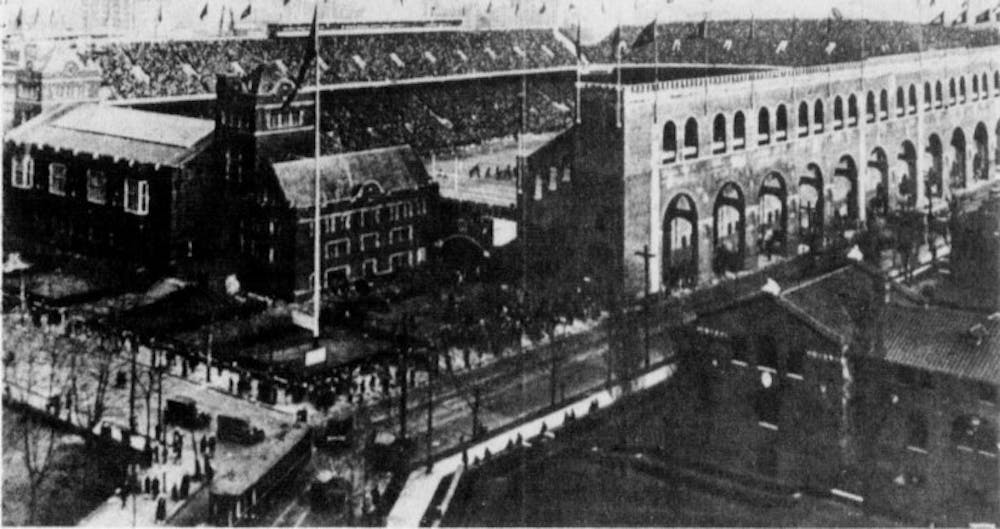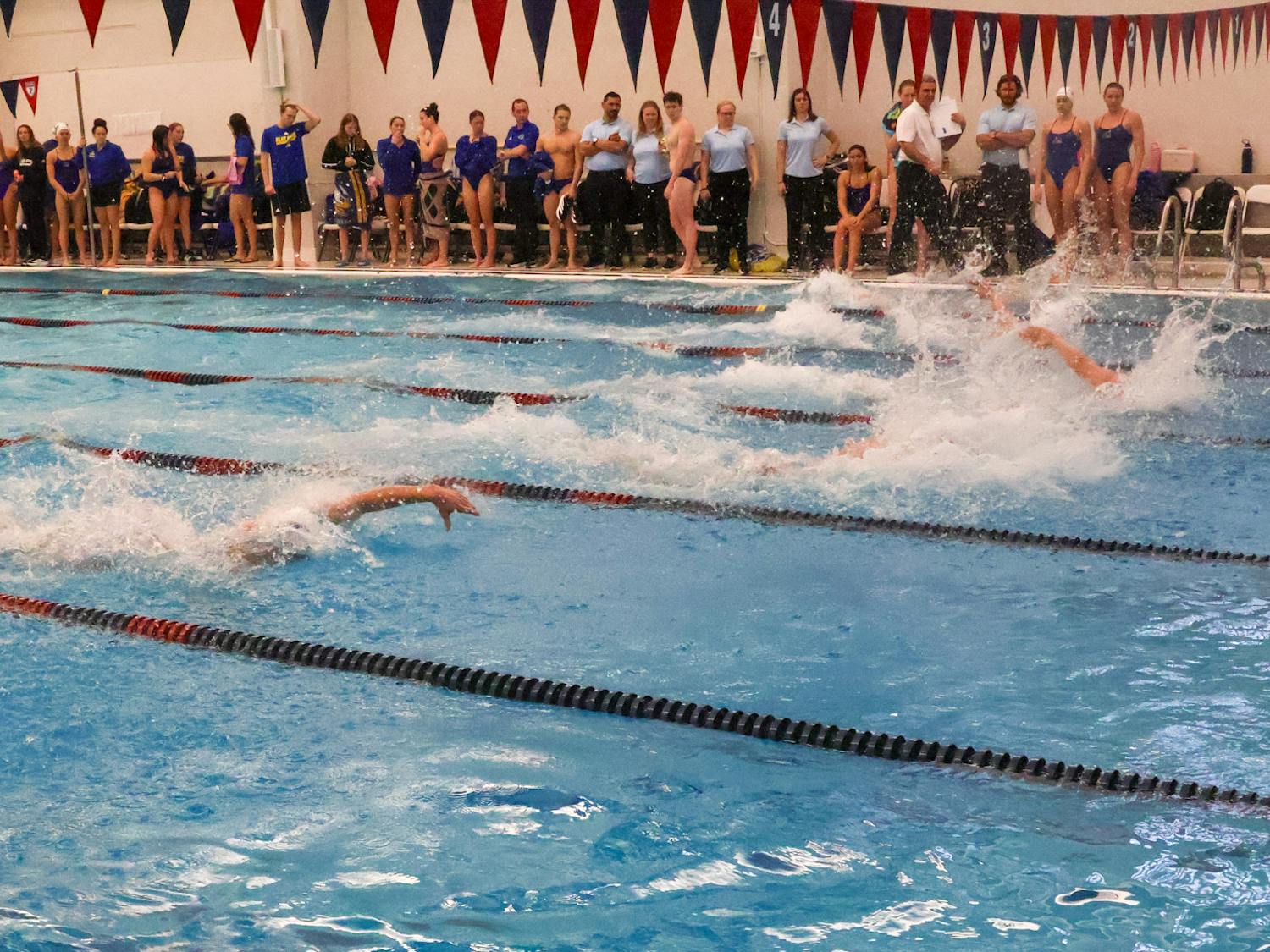The oldest Division I college football stadium in the nation. The oldest two-tiered stadium in the country. The fourth largest FCS venue. A maximum seating capacity upwards of 52,000. First and foremost, though, home to the Penn Quakers.
On the precipice of its 14th decade with its doors open, historic Franklin Field stands not only as a Penn staple, but also as a Philadelphia landmark. It has housed Penn football, sprint football, track and field, and lacrosse for years, as well as commencement, intramural and club sports, military training, and the opera — to name a few. Here’s a look back on the storied history of Franklin Field.
1895
Built to house the running of the first Penn Relays, $100,000 — equivalent to approximately $3.6 million in 2023 — was dedicated to the construction of Franklin Field in April 1895. Equipping the help of architects Frank Miles Day and Brother, Charles Klauder, construction of a permanent stadium began at the turn of the century. The original site — named after the university’s founder, Benjamin Franklin — featured its signature horseshoe shape, a quarter-mile track, football field, baseball diamond (the site was home to the Penn baseball team until 1924), and indoor training facilities.
Later that year, Penn football played its first game at Franklin Field — marking the use of the nation’s first scoreboard. After ten straight shoutout games to spark the season, the Quakers would cap the 1895 season with a pristine 14-0 record.
1916
From its early years, Franklin Field has boasted a multipurpose nature. Prior to its brief stint as the host site of Spring Fling from 2008-2016, Franklin Field hosted Verdi’s Grand Opera Aida to a crowd of over 30,000 people in 1916 — the first large-scale, open-air opera in the United States.
1922
RELATED:
Franklin Field among stadiums considered for Congressional protection
Long before the Linc, the Eagles called Franklin Field their home
1922 marks a monumental year in the stadium’s history, it’s the year Franklin Field became the Franklin Field we know today. After the original wooden bleachers were torn down, the concrete lower tier was constructed. In 1925, designers Day & Klauder added the bowl’s second tier, crafting the historic skeleton that has remained unchanged to this day.
1922 also saw the first football radio broadcast, originating from none other than Franklin Field. Carried by Philadelphia’s WIP station, the broadcast aired the Penn-Cornell rivalry for the thousands of fans tuned in. In 1940, the first commercially televised college football game also took place at Franklin Field when Philco Radio & Television Corporation televised Penn’s 51-0 blowout of the Maryland Terrapins.
1936
The history of Franklin Field extends into politics as well. On June 27, 1936, then-president Franklin D. Roosevelt concluded the Democratic National Convention at the stadium when he delivered his speech accepting the nomination for his second presidential term. In what may be one of the largest crowds the stadium has ever seen, Franklin Field opened its doors to over 100,000 people that evening.
1958
Franklin Field entered its NFL era in 1958 when The Philadelphia Eagles called the stadium home for the first time.
In order to accommodate larger crowds, the Eagles made the move from Connie Mack Stadium following the 1957 season. During the team's stint at Franklin Field, it held the 1960 NFL Championship Game, when the Birds defeated Green Bay 17-13 aided by the efforts of linebacker/center and Penn alumnus Chuck Bednarik. The Eagles played their final game at Franklin Field in 1970, before moving to Veteran’s Stadium.
Other professional sports have had their debuts at Franklin Field as well, such as when the Philadelphia Atoms of the North American Soccer League relocated there for the 1976 season and welcomed soccer great Pelé in a game against the New York Cosmos. Additionally, the first Rugby League match between the United States and Australia in 2004, and the inaugural championship game for Major League Ultimate in 2013 were both hosted at the stadium.
1968
Home to many “firsts'', Franklin Field is widely considered the birthplace of Philadelphia's negative reputation when it comes to sports fans. On December 15, 1968 — during an already rough Eagles performance — a cheery Christmas performance planned for halftime turned sour when bad weather struck, and the scheduled Santa Claus appearance had to be canceled.
Fans, already spewing expletives to the players and coaches, were unamused by the stand-in Santa — a young fan invited to the field to toss candy canes with the cheerleaders — and began to loudly boo as they tossed snowballs on the field.
The Eagles went on to lose the game 17-13, and Philadelphia fans lost respect by many, sparking the “worst sports fans” stereotype.
1969
Though its structure remains intact, Franklin Field has gone through a plethora of enhancements and improvements. The natural grass was replaced with AstroTurf in 1969, and due to the Eagles’ residency at the time, it became the first NFL stadium to make the switch to artificial turf.
1986
When a Penn student thinks of Commencement, an image of Franklin Field surely flashes in their mind. Ever since 1986, the University’s Commencement Ceremonies have been held at Franklin Field, having brought notable speakers such as Barbara Bush (1990), Hillary Clinton (1993), Jimmy Carter (1998), Bono (2004), Denzel Washington (2011), John Legend C’99 (2014), and most recently, Idina Menzel (2023).
1997
Bono’s 2004 visit to Franklin Field as Commencement Speaker wasn’t his first. Seven years earlier, the lead singer and popular Irish band, U2, held its Philadelphia show at Franklin Field while on the first leg of their PopMart Tour to a sold out crowd of over 50,000 people.
2000
No category remains untouched by Franklin Field’s history, as the site has dabbled in cinema too. As one of the primary filming locations for M. Night Shyamalan’s Unbreakable, Bruce Willis’s character is pictured as a security guard in the stadium in part one of the trilogy.
2023
Due to current construction efforts on College Hall, the Class of 2027's Convocation ceremony this year was held on Franklin Field — another "first" to add to the stadium's already lengthy list. Whether future Convocation ceremonies will resume on College Green or not remain uncertain.
Franklin Field and its historics continue to make headlines today as just a couple of weeks ago, it was one of 18 stadiums designated for Congressional protection.
Members of Congress announced on Aug. 25 the creation of the Historic Stadium Caucus, a non-partisan group devised to preserve the “integrity” of college football venues. Part of the conservation mission would focus on enhancing security and making technological upgrades. For a stadium so rich with history, such as Franklin Field, said efforts would go a long way towards keeping its character alive for decades to come.








